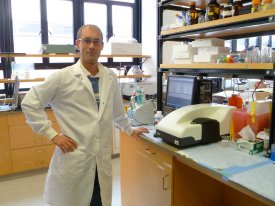Dr Vuk Uskokovic, from the Department of Preventive and Restorative Dental Sciences, School of Dentistry at the University of California, San Francisco (UCSF), is involved in a study that aims to mimic the growth of tooth enamel in the laboratory. A key analytical tool in this NIH-funded project is the Zetasizer Nano particle characterization system from Malvern Panalytical.
Harnessing the combined dynamic light scattering (DLS) and zeta-potential measurement capabilities of the instrument, Dr Uskokovic and his colleagues have been able to characterize the interaction between amelogenin protein, which makes up 90% of the enamel matrix, and the mineral component, hydroxyapatite. Self assembly of this particular protein is thought to be responsible for guiding the formation of enamel crystals.
 Dr Vuk Uskokovic, the Department of Preventive and Restorative Dental Sciences, School of Dentistry at the University of California, San Francisco, and his Zetasizer Nano ZS from Malvern Panalytical.
Dr Vuk Uskokovic, the Department of Preventive and Restorative Dental Sciences, School of Dentistry at the University of California, San Francisco, and his Zetasizer Nano ZS from Malvern Panalytical.
While dental techniques are often highly sophisticated, those available for restoring damaged dental tissue are less than perfect. Consequently there is a requirement for approaches that minimise tissue loss. According to Dr Uskokovic, if we understand how enamel forms naturally we can use the same compounds to rebuild the damaged enamel.
In a paper entitled, 'Zeta-potential and Particle Size Analysis of Human Amelogenins', (Uskokovic et al., J Dent Res 89(2):149-153, 2010) Dr Uskokovic and his colleagues deliver results that suggest that: "zeta-potential may be used as a control parameter in replicating the assembly of amelogenins in vitro." The authors also note that: "…the meaning of the correlations established [in the paper] between zeta-potential and particle-particle attraction could be potentially applied to self-assembling proteins in general."
When asked why he selected Malvern Panalytical's Zetasizer Nano for his work, Dr Uskokovic said: "I had previous experience with the Zetasizer Nano, albeit with more robust inorganic substances, so when asked to purchase a protein particle characterization system I knew it might be a good candidate. In a side by side trial with a competitive product, there was no contest. Results from the Zetasizer Nano were both more reliable and more robust."
Dr Uskokovic continued: "Proteins are sensitive to electric fields and during zeta potential measurements proteins are known to accidentally 'cook' if you're not careful. To achieve usable results, it was therefore necessary to fine tune our procedures to overcome these challenges and it was a huge advantage to have the experts at Malvern Panalytical so readily available to answer questions and deliver detailed guidance. As a result, I am now able to pass on this tutelage to students volunteering in our lab."
Having completed the initial study covering the characterization of amelogenin protein, including its proteolytic cleavage products, as published in the Journal of Dental Research, Dr Uskokovic is currently awaiting publication of a more comprehensive paper focusing on the interaction between amelogenin and its mineral counterpart in enamel.
Malvern Panalytical Zetasizer Nano delivers high quality DLS and zeta potential measurements in a single instrument. The combination of these techniques, and the reliability of results, makes the instrument ideal for protein characterization.